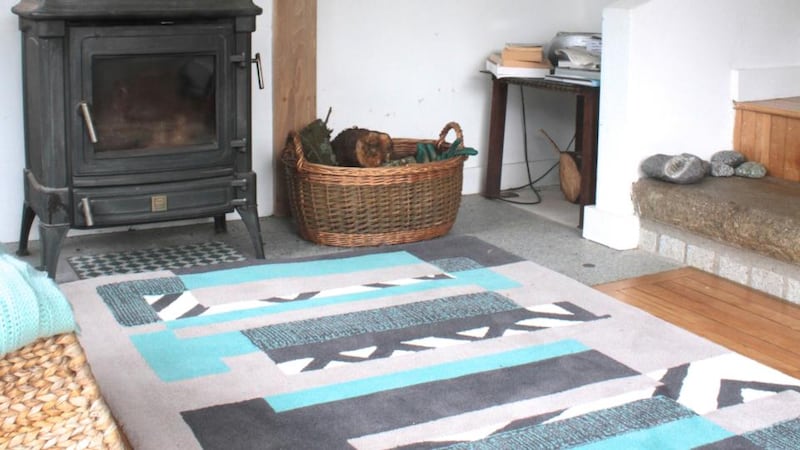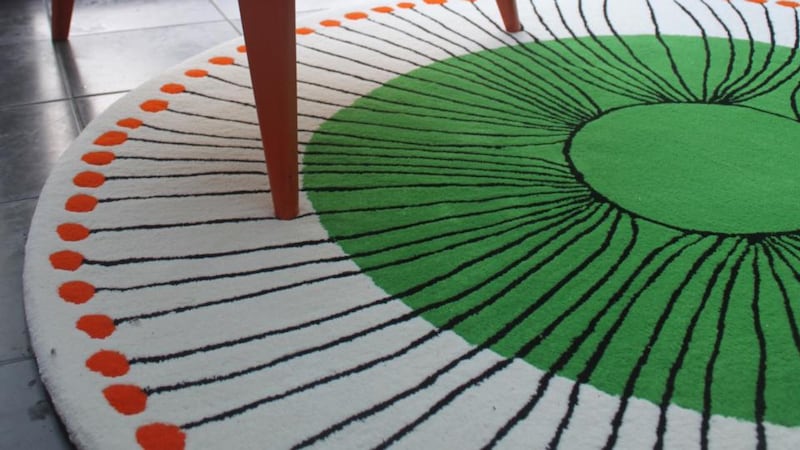For nearly 30 years, Denis Kenny has been tufting some of the most beautiful and desirable rugs in the country. It all began when he and his wife Fiona Gilboy, a teacher from Mayo, took over a humble 4x2 hearth rug business in Wexford in 1981 founded by Tom Ceadogán, a dyehouse master.
Today, Ceadogán is one of Ireland’s most successful small artisan companies whose striking handtufted rugs decorate the walls and floors of embassies, hotels and private houses. When the couple bought the company, they set about expanding the range and introduced bolder, design-led items, with many ideas arising from Gilboy’s passion for ceramics and tribal art. “It was a steep learning curve,” they say, recalling those challenging early years building a business and rearing a family in south Wexford.
Their location, one full of history, on the shores of Bannow Bay in Wellingtonbridge, could not be more idyllic. Traces of the estate that once belonged to a Cromwellian general called King still linger: in a field alongside the house stands a Norman tower while further away are the derelict remains of an unproductive silver mine built in the 16th century by speculative engineers sent by Henry VIII.


Abstract pattern
Ceadogán’s design studio, showroom and yarn barn are housed in handsome 18th century farm buildings and visitors are greeted by hens and cocks scratching around in the yard. On the day of our visit a rug designed by NCAD textile graduate Katie Hessian for a private client in Limerick was in the first stages of execution in one of the outbuildings.
The design, an abstract pattern in earth tones for a 7ft x 6.6ft floor rug, destined to be the centrepiece of a living room, was projected and magnified onto a large backing cloth frame suspended and stretched on a steel scaffold. Kenny shows how the first step was to trace the outlines of the pattern with a pen and assess the amount of yarn required in the various shades.
The rugs are made in New Zealand wool or silk/wool mixes classified by shade groups in the yarn stockroom, a former haybarn. There are also cones of bamboo, hemp and even paper for more experimental work, as well as natural undyed wool from Jacob’s sheep. The yarn is bought by the ton from Yorkshire spinners and then sent to Cushendale in Graiguenamanagh to be dyed.
For the actual rugmaking, the basic machinery is a tufting gun. Like a drill with a very complex head attached to tubes of compressed air and electricity, it traverses the outline of the pattern, shooting the yarn through the fabric in ‘U’ tufts.
“The rug will take two weeks to complete,” says Kenny, as Chris Morawiak, a whizz-kid former Polish miner demonstrates the technique. “Plain tufting is fast, but details slow you down hugely. Gun tufting is very specialised. It’s like sewing but you are working on a vertical frame. Mastering it is another story.”
Design and craftsmanship
When the rug is complete, it will be sheared with a machine or carved, a process that cuts deep into the pile to accentuate the design detail. The rug is then backed with latex twice and bordered with webbing.
“I am a stickler for quality,” says Kenny whose first big commission was a 45ft rug for Kelly’s Resort Hotel in Rosslare. The biggest one ever made was a massive wall hanging 5m x 3m for the Merchant Hotel in Belfast four years ago. Visitors to Irish embassies from London and Berlin to Ottawa and Dar es Salaam will have walked on Ceadogán’s piles.
The most recent commission was another rug for Kelly’s in association with Peter Johnson Interiors.
The company’s commitment to design and craftsmanship has been consistent. Over the years they have worked with many leading textile designers on a freelance basis and more recently collaborated on a module with NCAD students.
The unique collection of the original abstract cubist designs of Irish modernist artist Mainie Jellett that made its debut in 2008 has been one of their most significant associations and continues to have contemporary relevance.
Many of the designs now hang in the Wexford Opera House and in the cafe of the National Gallery of Ireland, while others continue to attract both private and corporate clients. The day of our visit one rug was heading to a customer in London following Ceadogán’s exhibition of the Jelletts at the Mid-Century Modern show there.
“They can be done in different sizes and different colourways as long as the original proportions are maintained,” says Kenny.
“They marry very well with mid-20th century furniture and the 50s trend,” Gilboy says.
The showroom gives an idea of the variety and colour of the differing design approaches, from the bold and graphic styles based on the clew created for the first Volvo Ocean Yacht Race by Ger Lambert to the mesmeric circular-shadow shaded rugs by Maree Hensey and the distinctive patterns of ceramicist Andrew Ludick. Their latest collaboration is with a young textile artist based in Bunclody of Welsh-Dutch origin called Hanneke Van Ryswyk.
Statement
Ceadogán also offers a design service for clients; for those who want something specific, they visit locations and develop ideas to suit the context.
“Some people start with a rug as a central point and work around it. It can be quite a statement and functions as sound absorption in modern houses where there is a lot of glass and steel,” says Gilboy.
In Dublin, Ceadogán’s rugs and wallhangings can be found in the Listening Rooms on Wicklow Street where prices range from €600 up to €1,800.













